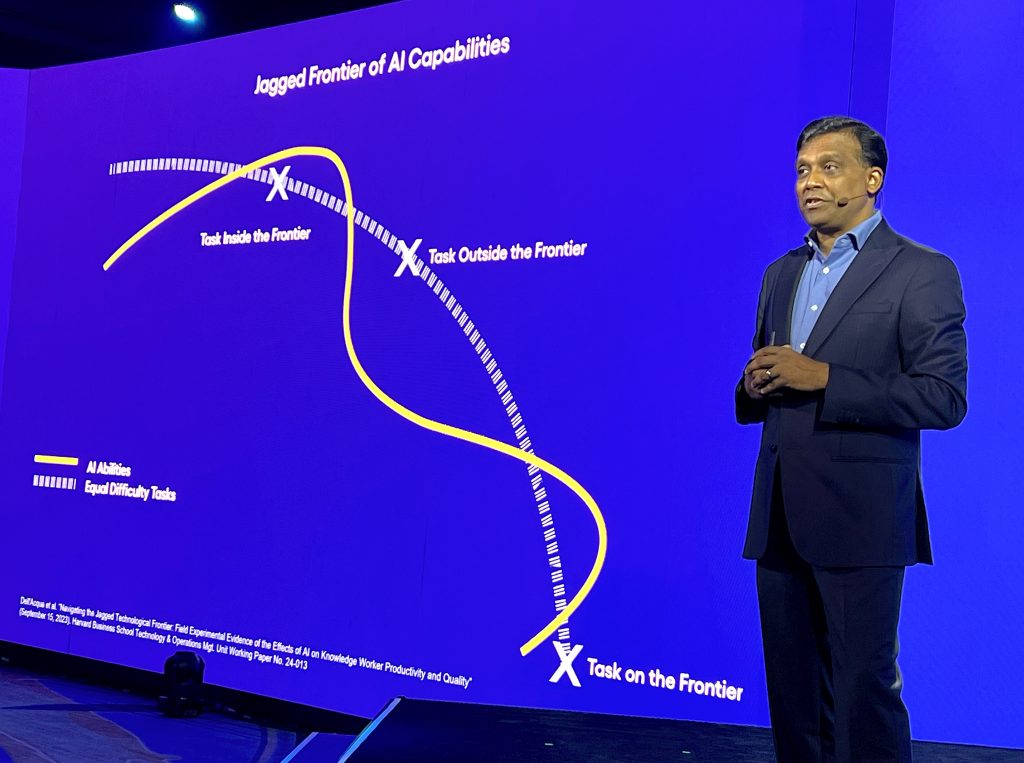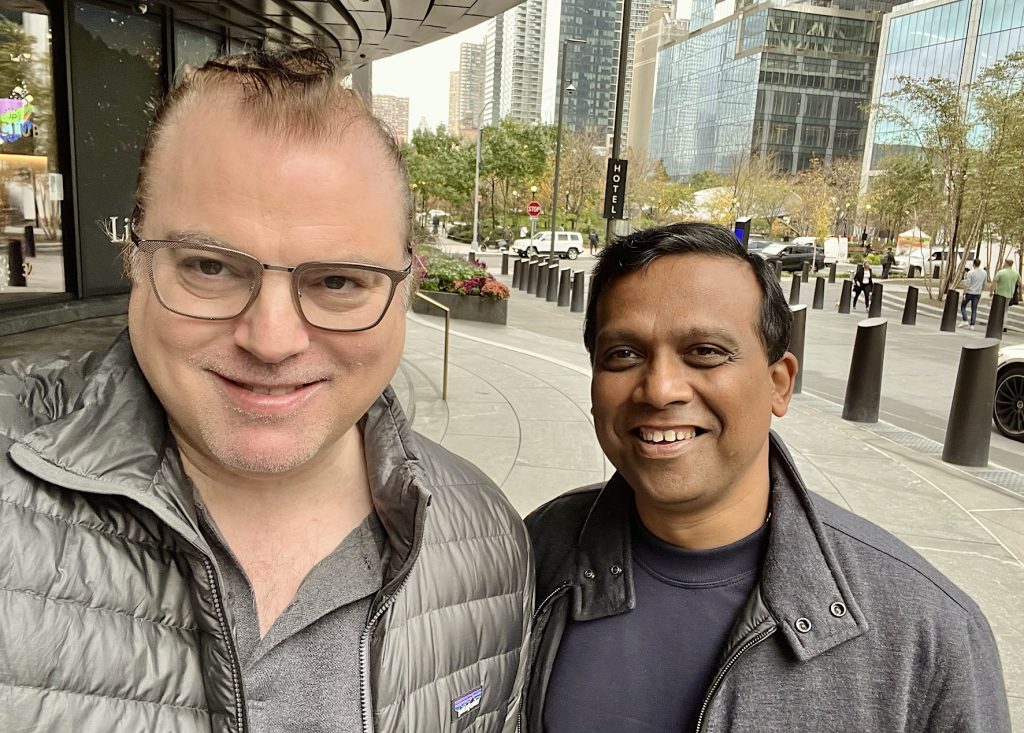Watch the videocast, here
Ravi Kumar, CEO of Cognizant and one of the leading voices in the global IT and business services industry for the last couple of decades has spent this year reshaping Cognizant as the firm surpasses the $20 billion services revenue milestone.
Talking with Ravi and hearing his developing thoughts, he has a deeper-than-ever focus on reversing the alarming commoditization trend of tech services by developing a talent strategy with a mindset grounded in creating new value through technology arbitrage value, not simply labor arbitrage.
Our most recent candid interview – as part of our GenAI Leaders Series – is to learn how Ravi is shaping things up at Cognizant in light of the opportunities and potential threats posed by GenAI…
Enterprises must do more with less and innovate in tandem
So, what are Cognizant clients doing to navigate the new business climate steeped in cost-cutting concerns alongside excitement and uncertainty about GenAI potential? Ravi described an accelerated pace of change that is occurring within the enterprise landscape, with technology as the foundation; all companies are now aspiring to become tech businesses and AI is becoming deeply embedded in business. Cognizant customers are looking to drive out costs and innovate in a hurry with equal determination. They are also focusing on the foundational elements of an AI-powered organization, including data readiness, privacy, security, and responsible AI.
This means firms like Cognizant must pivot their value proposition; getting stuck in Horizon 1 of cost-cutting and process optimization means continuing to live in the legacy world of commodity cost-savings-focused engagements. Cost savings are important, but ambitious providers have to keep striving for the co-creation of new sources of value to stay competitive in today’s era of rapid AI deployment. Many service providers have maximized the cost and efficiency levers in recent years, and now the focus is firmly shifting to genuine business transformation to provide faster, smarter data to drive rapid decision-making. That is the new lever that must be pulled in these engagements to deliver new thresholds of performance out of the business and support the growth agenda. Providers must support their clients to optimize and innovate at an equal pace in order to keep up with the competition and do the same themselves.
Gen AI creates a whole new workflow paradigm: enter, the jagged frontier
Ravi describes his view of the evolution of GenAI as a “jagged technological frontier.” This jagged frontier implies an uneven edge, where task allocation is irregular and the output quality is very disparate. Some operational tasks are easily done by AI, while other tasks of a seemingly similar difficulty are outside the current capability of AI. For a workflow designer, this means GenAI-capable tasks can fluctuate over the course of an employee’s workflow, with some tasks falling inside and others outside the frontier. You always need a human in the loop, at least with the AI we have today. The jagged edge GenAI creates for workflows is driving a whole new workforce dynamic that is both exciting and daunting. Let’s dive in on how this jagged frontier is playing out within Cognizant and for its clients….

GenAI is poised to amplify human production; the bottom half of workers will benefit most, but will overall improve productivity
There are two core areas where Ravi sees GenAI as having the most impact: the amplification of productivity within the delivery of services, particularly for developers and customer service staff, and augmenting customer ecosystems.
When we wrote about the new S-curve of value creation for GBS, we noted the rapid maturation of GenAI promises a significant productivity improvement (not just incremental) in voice-based work, coding, testing, and transactional processing. There’s also the promise of AI-driven operations to support autonomous decision-making, exception processing, and the capability to handle a more creative scope of work beyond mundane and boring activities.
This aligns with Cognizant’s view of the evolving GenAI capabilities, where human talent is both augmented and accelerated. Ravi sees a particularly significant impact on developers for equalizing performance; he cites a report that concluded that the bottom low-performing developers benefit much more from GenAI than high-performers when evaluated on the quality of output performance. This levels the playing field for talent across proficiency levels and offers a big opportunity to improve the developer productivity lifecycle.
“Every job can be upwardly mobile if you can use the power of technology, the power of AI, and make people do more value-added jobs and more prosperous jobs so that they see the value in embracing technology. So, while technology related to AI is going to eliminate jobs, it’s going to create upwardly mobile jobs.” –Ravi Kumar
The future workforce is driven by capability equalization and net new, different jobs
While Ravi also reminds us that any big disruptive opportunity is also a threat and cautious enthusiasm is the right tone to strike, Ravi firmly believes that the evolution of GenAI will create new jobs and impact the future workforce in a positive way. The shifting of agency to the end user brings a new opportunity for tech to be used to empower ourselves and our employees in their jobs. Generative AI still requires a human in the loop, and as a result, we will re-invent our workforce, and the types of jobs we need in the services industry will change. As Ravi puts it, “We will need more problem finders versus problem solvers; it will require more heuristic and creative skills, which will make this industry much more diverse.” That diversity of thought and people is something that services firms must embrace to refresh and reinvigorate the industry.
Moreover, in terms of the overall volume of jobs, Ravi is bullish on the GenAI shift as a catalyst for job growth in the services industry rather than the commoditization that has been threatened for decades every time a shiny new tech is introduced. “Looking back, technology actually created more jobs of the future than it’s taken away jobs of the past – so I’m very optimistic that it is going to create significantly more jobs for the future.”
AI first, machine + people is the future of work; services firms are the arbiters of change
Tech services firms are going through a transition fueled by these technology advancements and labor shifts. While the enterprise landscape is being completely reshaped by GenAI, and resistance to change is high, leading services firms will help connect their clients’ organizations to the broader GenAI ecosystem, and their partners must be in lockstep with them to navigate the changes.
Looking ahead, Kumar predicts that the world will become an AI-first, machine-plus-people endeavor. AI will lead to more tech intensity, more budget allocation due to higher productivity, and a greater need for creative and heuristic skills. This is an opportunity for the services industry to develop top talent for new and exciting tasks that shun the mundane and repetitive roles of the future and create fun, human things for people to do.
As technology becomes more central to enterprise landscapes, the traditional labor arbitrage value proposition will fade into the distance as technology arbitrage becomes the central role of the service provider.
“Technology arbitrage is the future of the services industry” – Ravi Kumar
The Bottom Line: Capability equalization of the jagged edge frontier will lead to the human amplification that the services industry desperately needs to deliver value.
There is still much work to do to bring the promise of GenAI to its potential in the services industry, and constant tech advancements and risks mean we cannot afford to take our eye off the ball for one minute. What is certain is that as enterprise operations and services leaders, we must be prepared for challenges, not least of which is a dearth of technology and business professionals prepared to ride the wave that an AI-powered enterprise requires, which is adopting a probabilistic mindset and an emboldened attitude to learn new methods and ways of doing things.
Bridging this divide we currently see ahead of us means better service partnerships, greater productivity as well as prosperity for workers, and greater job satisfaction leading to better outcomes across this new generative ecosystem.
Posted in : Artificial Intelligence, ChatGPT, GenAI, GenAI Leaders Series, Generative Enterprise, GPT-4, IT Outsourcing / IT Services, OneOffice, Talent and Workforce, Talent in Sourcing, The Generative Enterprise








Great coverage of AI jagged edge and productive service collaborations. As a tech lawyer I see alliances and winners and losers who provide /use their archives to train ML and GenAI. AI needs human oversight and insights
Best regards. Bill